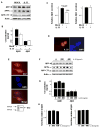Transcriptomic and genetic studies identify IL-33 as a candidate gene for Alzheimer's disease
- PMID: 19204726
- PMCID: PMC2860783
- DOI: 10.1038/mp.2009.10
Transcriptomic and genetic studies identify IL-33 as a candidate gene for Alzheimer's disease
Abstract
The only recognized genetic determinant of the common forms of Alzheimer's disease (AD) is the epsilon 4 allele of the apolipoprotein E gene (APOE). To identify new candidate genes, we recently performed transcriptomic analysis of 2741 genes in chromosomal regions of interest using brain tissue of AD cases and controls. From 82 differentially expressed genes, 1156 polymorphisms were genotyped in two independent discovery subsamples (n=945). Seventeen genes exhibited at least one polymorphism associated with AD risk, and following correction for multiple testing, we retained the interleukin (IL)-33 gene. We first confirmed that the IL-33 expression was decreased in the brain of AD cases compared with that of controls. Further genetic analysis led us to select three polymorphisms within this gene, which we analyzed in three independent case-control studies. These polymorphisms and a resulting protective haplotype were systematically associated with AD risk in non-APOE epsilon 4 carriers. Using a large prospective study, these associations were also detected when analyzing the prevalent and incident AD cases together or the incident AD cases alone. These polymorphisms were also associated with less cerebral amyloid angiopathy (CAA) in the brain of non-APOE epsilon 4 AD cases. Immunohistochemistry experiments finally indicated that the IL-33 expression was consistently restricted to vascular capillaries in the brain. Moreover, IL-33 overexpression in cellular models led to a specific decrease in secretion of the A beta(40) peptides, the main CAA component. In conclusion, our data suggest that genetic variants in IL-33 gene may be associated with a decrease in AD risk potentially in modulating CAA formation.
Conflict of interest statement
Dr. Lambert reports being a consultant to Genoscreen
Figures



Similar articles
-
APOE epsilon 4 influences the pathological phenotype of Alzheimer's disease by favouring cerebrovascular over parenchymal accumulation of A beta protein.Neuropathol Appl Neurobiol. 2003 Jun;29(3):231-8. doi: 10.1046/j.1365-2990.2003.00457.x. Neuropathol Appl Neurobiol. 2003. PMID: 12787320
-
Capillary cerebral amyloid angiopathy identifies a distinct APOE epsilon4-associated subtype of sporadic Alzheimer's disease.Acta Neuropathol. 2010 Aug;120(2):169-83. doi: 10.1007/s00401-010-0707-9. Epub 2010 Jun 10. Acta Neuropathol. 2010. PMID: 20535486
-
Impact of sex and APOE4 on cerebral amyloid angiopathy in Alzheimer's disease.Acta Neuropathol. 2016 Aug;132(2):225-234. doi: 10.1007/s00401-016-1580-y. Epub 2016 May 14. Acta Neuropathol. 2016. PMID: 27179972 Free PMC article.
-
Cerebral amyloid angiopathy and its relationship to Alzheimer's disease.Acta Neuropathol. 2008 Jun;115(6):599-609. doi: 10.1007/s00401-008-0366-2. Epub 2008 Mar 28. Acta Neuropathol. 2008. PMID: 18369648 Review.
-
Apolipoprotein E genotype and cerebral amyloid angiopathy-related hemorrhage.Ann N Y Acad Sci. 2000 Apr;903:176-9. doi: 10.1111/j.1749-6632.2000.tb06366.x. Ann N Y Acad Sci. 2000. PMID: 10818505 Review.
Cited by
-
Cytokine signaling convergence regulates the microglial state transition in Alzheimer's disease.Cell Mol Life Sci. 2021 May;78(10):4703-4712. doi: 10.1007/s00018-021-03810-0. Epub 2021 Apr 13. Cell Mol Life Sci. 2021. PMID: 33847763 Free PMC article. Review.
-
The role of IL-1 family of cytokines in the pathogenesis and therapy of Alzheimer's disease.Inflammopharmacology. 2024 Oct;32(5):2681-2694. doi: 10.1007/s10787-024-01534-8. Epub 2024 Aug 10. Inflammopharmacology. 2024. PMID: 39126573 Review.
-
Critical Roles of IL-33/ST2 Pathway in Neurological Disorders.Mediators Inflamm. 2018 Feb 4;2018:5346413. doi: 10.1155/2018/5346413. eCollection 2018. Mediators Inflamm. 2018. PMID: 29507527 Free PMC article. Review.
-
The NLRP3 and NLRP1 inflammasomes are activated in Alzheimer's disease.Mol Neurodegener. 2016 Mar 3;11:23. doi: 10.1186/s13024-016-0088-1. Mol Neurodegener. 2016. PMID: 26939933 Free PMC article.
-
Both common variations and rare non-synonymous substitutions and small insertion/deletions in CLU are associated with increased Alzheimer risk.Mol Neurodegener. 2012 Jan 16;7:3. doi: 10.1186/1750-1326-7-3. Mol Neurodegener. 2012. PMID: 22248099 Free PMC article.
References
-
- Cruts M, Van Broeckhoven C. Molecular genetics of Alzheimer’s disease. Ann Med. 1998;30:560–565. - PubMed
-
- Farrer LA, Cupples LA, Haines JL, Hyman B, Kukull WA, Mayeux R, Myers RH, Pericak-Vance MA, Risch N, van Duijn CM. Effects of age, sex, and ethnicity on the association between apolipoprotein E genotype and Alzheimer disease. A meta-analysis. APOE and Alzheimer Disease Meta Analysis Consortium. JAMA. 1997;278:1349–1356. - PubMed
-
- Lambert JC, Amouyel P. Genetic heterogeneity of Alzheimer’s disease: complexity and advances. Psychoneuroendocrinology. 2007;32:S62–S70. - PubMed
-
- Bertram L, McQueen MB, Mullin K, Blacker D, Tanzi RE. Systematic meta-analyses of Alzheimer disease genetic association studies: the AlzGene database. Nat Genet. 2007;39:17–23. - PubMed
Publication types
MeSH terms
Substances
Grants and funding
LinkOut - more resources
Full Text Sources
Other Literature Sources
Medical
Molecular Biology Databases
Miscellaneous

